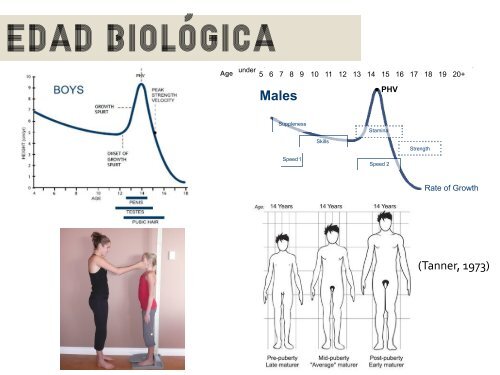Create successful ePaper yourself
Turn your PDF publications into a flip-book with our unique Google optimized e-Paper software.
Edad biológica<br />
<br />
urement<br />
tadiometer with<br />
d on knees.<br />
lightly against<br />
ned vertically<br />
e is no gap<br />
d stadiometer.<br />
ds traction to the<br />
he trunk is fully<br />
the students<br />
o the nearest<br />
, it can be<br />
re, in order to<br />
age. The terms “growth” and “maturation” are often more years earlier or later than average.<br />
Suppleness<br />
Strength<br />
used together and sometimes synonymously; however, Peak Height Velocity (PHV) is the fastest 1 & 2 rate of growth<br />
each refers to specific biological activities.<br />
during the adolescent growth spurt. Figures 3 and 4<br />
illustrate PHV for girls and boys respectively, pointing<br />
Rate of Growth<br />
Growth refers to observable step-by-step changes in out the differences between them. The charts also<br />
quantity and measurable changes in body size such as identify secondary sex characteristics with relation to<br />
height, weight, and fat percentage. Maturation refers growth.<br />
Developmental Age<br />
to qualitative system changes, both structural and<br />
Chronological<br />
functional, in the body’s progress toward maturity such under<br />
Age 5 6 7 8 9 10 11 12 13 14 15 16 17 18 19 20+<br />
as the change of cartilage to bone in the skeleton.<br />
<br />
PHV<br />
Long-Term Athlete Development (LTAD) requires the <br />
Males<br />
Protocol for Standing Height Measurement<br />
identification of early, average and late maturers<br />
(Simmons, 2000)<br />
hair and penis are related to the maturation process.<br />
in order to help to design appropriate training and<br />
<br />
• The competition student stands programs erect in bare in relation feet with heels, to optimal trainability<br />
Suppleness<br />
buttocks pronounced late gain in strength characteristics of the<br />
and readiness. and shoulders The pressed beginning against of the the growth spurt and<br />
Stamina<br />
stadiometer.<br />
the peak of the growth spurt are very significant in male athlete. As with girls, the developmental sequence<br />
• The heels are together with arms hanging freely by<br />
Skills<br />
the LTAD side applications (palms facing thighs). to training and competition design. for male athletes may occur two or more years earlier Strength<br />
• The tester applies gentle upward traction to the<br />
or later than average. Speed Early 1 maturing boys may have as<br />
skull behind the ears.<br />
much as a four-year physiological advantage over Speed their 2<br />
• The student looks straight ahead, takes a deep<br />
breath and stands as tall as possible.<br />
late-maturing peers. Eventually, the late maturers will<br />
• Draw down the measuring bar to the student’s<br />
head and record standing height to the nearest<br />
catch up when they experience their growth spurt.<br />
0.1<br />
Figure<br />
cm.<br />
2. Maturation in Girls and Boys (Adapted and modified from Tanner, 1973)<br />
Rate of Growth<br />
Figure 9. Measuring Standing Height<br />
Physical, Mental - Cognitive, Emotional Development<br />
t<br />
Currently, most athletic training and competition programs<br />
are based on chronological age. However, athletes of the<br />
same age between ages 10 and 16 can be three<br />
to five years apart developmentally (Borms, 1986).<br />
Thus, chronological age is a poor guide to segregate<br />
adolescents for competitions.<br />
Sports need to develop strategies that will encourage late<br />
maturing boys to remain in sport until they have caught<br />
up developmentally with their early maturing peers,<br />
who because of their increased size and strength have a<br />
competitive advantage. For girls, there is a need to develop<br />
strategies to retain early developers in programs until<br />
the competitive disadvantage of wider hips and breast<br />
development is reduced as late developers also obtain more<br />
adult body shapes.<br />
(Tanner, 1973)



